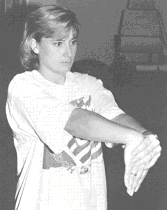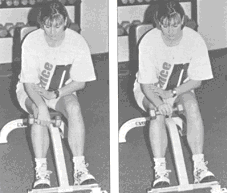Newsletter Summer 03: Tennis Elbow
The Tennis Player's Guide to "Tennis Elbow"
By: Tanya Vrga, Exercise Sports Specialist
Tennis elbow (or more technically lateral epicondilitis) is an injury that tennis players are prone to due to the overuse of their extensor muscles located in the forearm. The extensor muscles are used to cock the wrist backward towards the elbow, used in the forehand and serve stroke. Other examples of activities that are prone to tennis elbow include golfers, typists and contractors that use a paintbrush or hammer.
Symptoms
-
Recurring pain on the outside of the upper forearm just below the bend of the elbow, occasionally, pain radiates down the arm toward the wrist.
-
Pain caused by lifting or bending the arm or grasping even light objects such as a coffee cup.
-
Difficulty extending the wrist fully (because of inflamed muscles, tendons and ligaments).
-
Pain that typically lasts for 6 to 12 weeks; the discomfort can continue for as little as 3 weeks or as long as several years.
Note: If you feel pain directly on the back of your elbow joint, rather than down the outside of your arm, you may have bursitis, which is caused when lubricating sacs in the joint become inflamed. If you see swelling, which is almost never a symptom of tennis elbow, you may want to investigate other possible conditions, such as arthritis, infection, gout or a tumor.

Causes
The most common cause of tennis elbow is overuse and repetitive motion of the muscles that pull the hand backwards (the wrist extensors). All the extensor muscles of the hand attach to the elbow (the radius) at the outer part (the lateral epicondyle of the radius). Tendon attaches the extensor muscles to the lateral epicondyle and it is this tendon attachment that becomes inflamed, painful and tender to touch.

Tennis players are prone to this injury because the extensor muscles are used to slow the racket down during the "follow through" phase of a tennis stoke. The extensor muscles are also involved and prone to injury because of the impact during the "critical instant" phase when the ball strikes the racquet. The damage that tennis elbow incurs consists of tiny tears in the tendon and in muscle coverings. If these micro traumas occur repetitively, without sufficient time to heal, degradation of the tendon will occur. In turn, the tendon becomes weaker, making it more susceptible to further tearing. This will lead to a long-term cyclical pattern that is difficult to break. The resulting pressure can cut off the blood flow and pinch the radial nerve, one of the major nerves controlling muscles in the arm and hand.
Tendons, which attach muscles to bones, do not receive the same amount of oxygen and blood that muscles do, so they heal more slowly. In fact, some cases of tennis elbow can last for years, though the inflammation usually subsides in 6 to 12 weeks.
Diagnosis
The doctor, physiotherapist or athletic therapist will test for tenderness over or near to the bony bump on the outside of the elbow (lateral epicondilitis). He or she will also test to see whether the pain gets worse when you bend the wrist back (extend it) against resistance. In the event of both these signs being present, it is likely that you have tennis elbow.
Your doctor may also examine your neck, as this may be the cause, or part of the problem. Many of the things that might strain your elbow might also put a strain on your neck.
Treatment
-
Rest the arm until the pain disappears.
-
Avoid activities that over use the elbow and hand.
-
Reduce pain and inflammation when the injury is in its acute stage by the use of cooling.
-
Physiotherapy treatments, which may include heat or ultrasound therapy
-
Use of anti-inflammatory drugs such as ibuprofen and ordinary painkillers (analgesics).
-
The doctor may suggest an injection of a small dose of steroid to the affected area. This is not the sort of steroid banned for athletes. If used it can last for up to three months, and although it may need to be repeated you seldom need more than two or possibly three injections.
-
You can buy a brace from a sports shop, pharmaceutical supplier, or physiotherapy clinic. The brace sits just below the elbow and is designed to tighten around the top of the extensor muscles. The result is when the extensor muscle contracts, when for example picking up your coffee, the muscle stops contracting at the brace and therefore the muscle is left relaxed at the area of injury.
If rest, anti-inflammatory medications, and a stretching routine fail to cure your tennis elbow, you may have to consider surgery, though this form of treatment is rare (fewer than 3 percent of patients). One procedure is for the tendon to be cut loose from the epicondyle, the rounded bump at the end of the bone, which eliminates stress on the tendon but renders the muscle useless. Another surgical technique involves removing so-called granulated tissue in the tendon and repairing tears.
Even after you feel you have overcome a case of tennis elbow, be sure to continue babying your arm. Always warm up your arm for 5 to 10 minutes before starting any activity involving your elbow. And if you develop severe pain after use, pack your arm in ice for 15 to 20 minutes and see a doctor.
Stretch and Strengthen
Strength and flexibility exercises, proper technique and selecting equipment appropriate for your style and body, play a crucial role in preventing tennis elbow.
Forearm Extensor Stretch (see diagram below)

Warm up for 10 minutes with some light cardiovascular exercise. This is to increase tissue temperature of the extensor muscle help to produce a permanent stretch. Example: stationary bike or jogging.
Starting Position: The elbow is straight and the forearm is pronated (palm down).
Stretch Action: Use the opposite hand to stretch the wrist downward (flexion), keeping the elbow straight.
Strengthening Exercises for the Extensors (see diagram below)

Equipment Required: Two-pound free weight or dyna band.
Starting Position for Free Weights: Sitting in a chair with the elbow flexed and forearm resting on a table or over your knee. Let the wrist and hand hang over the edge. Turn the hand so the palm is down.
Exercise Action: Stabilize the forearm with the opposite hand, and slowly curl your wrist and the weight in hand upward. Be sure to move only at your wrist, not at your elbow. Raise your hand slowly, hold for one count and slowly lower weight for three counts. Repeat 10 times. Rest for two minutes. Repeat set 2 more times for a total of 3 sets of 10 repetitions. Increase the weight after two weeks or whenever the weight gets too easy at the end of the 10 repetitions.
Dyna Band: Secure the band under your foot or at the base of a table and see instructions above for correct form.
Note: Stop if you feel pain. Your tennis elbow injury may not have heeled enough to begin strengthening exercises.
Your Tennis Game and Prevention of Tennis Elbow
Several aspects of your tennis equipment can affect your arm.
String Tension
The tighter your strings are the more control you will have; the looser the strings the more powerful your racket becomes. If you have tennis elbow, decrease your string tension two to four pound. Lower string tension reduces impact shock and increases the power of you racket slightly so you do not have to work as hard. However, decreasing the tension too much will lead to a loss of control if your stroke technique does not change as well to accommodate the increased power from looser strings.
Vibration Dampeners
Vibration dampeners have no affect on tennis elbow. Research performed by Dr. Howard Brody has shown that these dampeners do affect high-frequency vibration coming off of your strings. But the dampeners are affecting the high frequency sound vibrations as opposed to absorbing shock that your elbow in incurring from the vibrations from the racquet. This explains the change in sound when playing with vibration dampeners.
Racquet Stiffness
Sports medicine professionals recommend racquets that are of midrange stiffness. Playing with a racquet that is too stiff will cause more abrupt shock or jarring sensations to the arm, compared with a more flexible racquet.
Following the manufacturer's guidelines for racquet string tension and looking for a medium stiff frame will assist you in choosing equipment that is right for your arm. Consult your certified tennis professional or racquet technician (stringer) for further guidance.
Strings
Gut strings give more resilience and less vibration than nylon ones.
Do not change your equipment just before big tournaments or periods of heavy tennis play. This will allow you to get used to your new or changed equipment gradually.
Technique
There are certain techniques in tennis that can contribute to tennis elbow. Hitting the ball when the racquet is too far in front of the body can cause tennis elbow. The contact point between the racquet and the ball should be beside the body so that "braking" does not occur when the ball is hit.
Inadequate rotation of the torso causes the hitting arm (including extensor muscles) to over compensate in order to generate power on a groundstroke. Correct sequence of your bodies' muscles unwinding is necessary to generate a powerful groundstroke. Think of the body as a kinetic chain of events. A chain works in a series of linked joints. Any disturbance in the sequencing of the links will throw off a shot. For a ground stoke, begin with planting the feet, then extend with the knees, then extend the hips, uncoil the torso, bring the arm forward from the shoulder and follow through with the racquet until the racquet finishes over the opposite shoulder.
Holding the racquet too tightly will cause tennis elbow. The racquet should be held with a grip similar to the grip you would use to get a buggie out of a cage. The only time you should tighten your grip is on impact with the ball.
Ball
The type of ball used to avoid tennis elbow should be as bouncy and lively as possible. There are inconclusive studies on which brand of balls scores highest in the realm of liveliness however, use your local tennis pros for advice, as they will certainly have an opinion of which balls they prefer. Use newer balls over older used balls. Old balls become hard and loose their bounce. Avoid wet balls as they become heavy.
Court
The court surface should be slow (clay) in order to decrease the velocity of the ball. Fast surfaces such as grass or concrete cause the ball to hit the racquet with increased force, resulting in increased load on the player's arm.
Braces
Many types of elbow braces are available to aid in the relief of and prevention of pain in associated with tennis elbow. Braces are used during each phase of the exercise rehabilitation program, as well as return to the sport or activity with less or no pain. When worn as directed, they do not cut off circulation, hamper movement or cause swelling.
Braces work by placing a compressive barrier between the muscles and the epicondyle. The painful portion of the extensor muscles is on the elbow side of the barrier and the greater parts of the extensor muscles (wrist side) can contract without the painful portion of the muscle contracting.
Some common and effective makers of the elbow brace include Serola Biomechanics' Gel Arc, Pro Band Sports Industries Inc' Band It Therapeutic Forearm Band, EpX' Tennis Elbow Support Band and Aircast' Pneumatic Armband.
Remember that this column is not a substitute for proper assessment and treatment by a health professional. If there is any doubt in your mind about your condition, please seek the advice of your health professional.


















